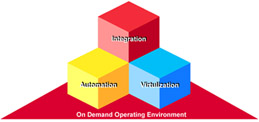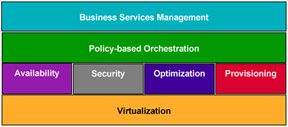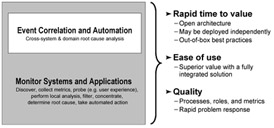1.4 Tivoli product structure
|
| < Day Day Up > |
|
1.4 Tivoli product structure
Let us take a look at how Tivoli solutions provide comprehensive systems management for the e-business enterprise and how the IBM Tivoli Monitoring for Transaction Performance product fits into the overall architecture.
In the hectic on demand environments e-businesses find themselves in today, responsiveness, focus, resilience, and variability/flexibility are key to conducting business successfully. Most business processes rely heavily on IT systems, so it is fair to say that the IT systems have to possess the same set of attributes in order to be able to keep up with the speed of business. To provide an open framework for the on demand IT infrastructure, IBM has published the On Demand Blueprint, which defines an On Demand Operating Environment with three major properties (Figure 1-10):
| Integration | Efficient and flexible combination of resources (people, processes, and information) to optimize resources across and beyond the enterprise. |
| Automation | The capability to dynamically deploy, monitor, manage, and protect an IT infrastructure to meet business needs with little or no human intervention. |
| Virtualization | Present computer resources in ways that allows users and applications to easily get value out of them, rather than presenting them in ways dictated by the implementation, geographical location, or physical packaging. |

Figure 1-10: The On Demand Operating Environment
The key motivators for taking steps to align the IT infrastructure with the ideas of the On Demand Operating Environment are:
| Align the IT processes with business priorities | Allow your business to dictate how IT operates, and eliminate constraints that prohibits the effectiveness of your business. |
| Enable business flexibility and responsiveness | Speed is the one of the critical determinants of competitive success. IT processes that are too slow to keep up with the business climate cripples corporate goals and objectives. Rapid response and nimbleness mean that IT becomes an enabler of business advantage versus a hindrance. |
| Reduce cost | By increasing the automation in your environment, immediate benefits can be realized from lower administrative costs and less reliance on human operators. |
| Improved asset utilization | Use resources more intelligently. Deploy resources on an as-needed, just-in-time basis, versus a costly and inefficient "just-in-case" basis. |
| Address new business opportunities | Automation removes lack of speed and human error from the cost equation. New opportunities to serve customers or offer better services will not be hampered by the inability to mobilize resources in time. |
In the On Demand Operating Environment, IBM Tivoli Monitoring for Transaction Performance plays an important role in the automation area. By providing functions to determine how well the users of the business transactions (the J2EE based ones in particular) are served, IBM Tivoli Monitoring for Transaction Performance supports the process of provisioning adequate capacity to meet Service Level Objectives, and helps automate problem determination and resolution.
For more information on the IBM On Demand Operation Environment, please refer to the Redpaper e-business On Demand Operating Environment, REDP3673.
As part of the On Demand Blueprint, IBM provides specific Blueprints for each of the three major properties. The IBM Automation Blueprint depicted in Figure 1-11 on page 30 defines the various components needed to provide automation services for the On Demand Operation Environment.

Figure 1-11: IBM Automation Blueprint
The IBM Automation Blueprint defines groups of common services and infrastructure that provide consistency across management applications, as well as enabling integration.
Within the Tivoli product family, there are specific solutions that target the same five primary disciplines of systems management:
-
Availability
-
Security
-
Optimization
-
Provisioning
-
Policy-based Orchestration
Products within each of these areas have been made available over the years and, as they are continually enhanced, have become accepted solutions in enterprises around the world. With these core capabilities in place, IBM has been able to focus on building applications that take advantage of these solution-silos to provide true business systems management solutions.
A typical business application depends not only on hardware and networking, but also on software ranging from the operating system to middleware such as databases, Web servers, and messaging systems, to the applications themselves. A suite of solutions such as the "IBM Tivoli Monitoring for..." products, enables an IT department to provide consistent availability management of the entire business system from a central site and using an integrated set of tools. By utilizing an end-to-end set of solutions built on a common foundation, enterprises can manage the ever-increasing complexity of their IT infrastructure with reduced staff and increased efficiency.
Within the availability group in Figure 1-11 on page 30, two specific functional areas are used to organize and coordinate the functions provided by Tivoli products. These areas are shown in Figure 1-12.

Figure 1-12: Tivoli's availability product structure
The lowest level consists of the monitoring products and technologies, such as IBM Tivoli Monitoring and its resource models. At this layer, Tivoli applications monitor the hardware and software and provide automated corrective actions whenever possible.
At the next level is event correlation and automation. As problems occur that cannot be resolved at the monitoring level, event notifications are generated and sent to a correlation engine, such as Tivoli Enterprise Console®. The correlation engine at this point can analyze problem notifications (events) coming from multiple components and either automate corrective actions or provide the necessary information to operators who can initiate corrective actions.
Both tiers provide input to the Business Information Services category of the Blueprint. From a business point-of-view, it is important to know that a component or related set of components has failed as reported by the monitors in the first layer. Likewise, in the second layer, it is valuable to understand how a single failure may cause problems in related components. For example, a router being down could cause database clients to generate errors if they cannot access the database server. The integration to Business Information Services is a very important aspect, as it provides an insight into how a component failure may be affecting the business as a whole. When the router failure mentioned above occurs, it is important to understand exactly what line of business applications will be affected and how to reduce the impact of that failure on the business.
|
| < Day Day Up > |
|
EAN: 2147483647
Pages: 105